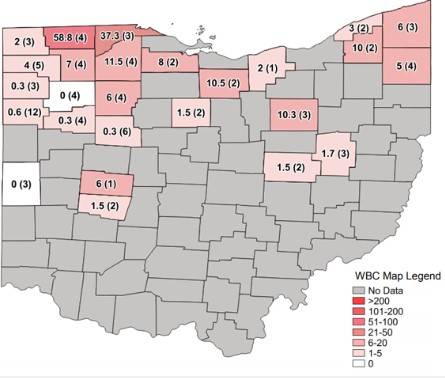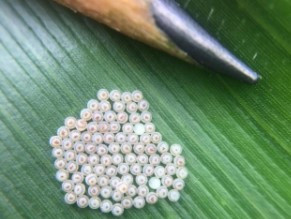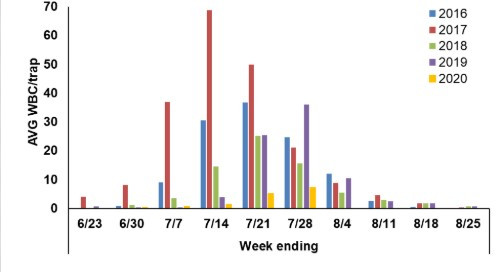By Amy Raudenbush and Mark Badertscher et.al
Western bean cutworm (WBC) trap counts for the week of July 20 – 26 continue to increase in many counties across Ohio. A total of 26 counties monitored 88 traps, resulting in 636 WBC adults (7.2 statewide average moths per trap) (Figure 1). Counties that are averaging more than 7 moths per week should begin scouting for egg masses (Figure 2). These counties include Fulton, Geauga, Henry, Huron, Lucas, Sandusky, Wayne, and Wood. While most monitoring counties continue to increase/remain the same, few are beginning to see decreases including, Coshocton, Darke, Hardin, Putnam, and Van Wert. The general trend of WBC for 2020 remains low compared to previous years (Figure 3).

Figure 1. Average Western bean cutworm adult per trap followed by total number of traps in the county in parentheses for week ending July 26, 2020.

Figure 2. Western bean cutworm egg mass.

Figure 3. Average number of Western bean cutworm (WBC) moths captured weekly in Ohio from 2016 to 2020.
Scouting guidelines
Scout pre-tassel corn approaching tassel fields. Choose at least 20 consecutive plants in 5 random locations (scout different areas of the field that may be in different growth stages). Inspect the uppermost 3–4 leaves. Consider treatment if >8% of inspected plants have eggs or larvae (field corn) or in sweet corn, if >4% of inspected plants have eggs or larvae (processing market), or >1% of plants (fresh-market).
Treatment
If the number of egg masses/larvae observed exceed threshold, many insecticides are available to adequately control WBC, especially those containing a pyrethroid. However, as with any ear-burrowing caterpillar pest, timing is critical. Insecticide applications must occur after egg hatch, or after tassel emergence, but before caterpillars enter the ear. If eggs have hatched, applications should be made after 95% of the field has tassel. If eggs have not hatched, monitor for the color change. Hatch will occur within 24–48 hours once eggs turn purple. To search for larval injury after it has occurred, search the corn for ears having feeding holes on the outside of the husks.
Source : osu.edu